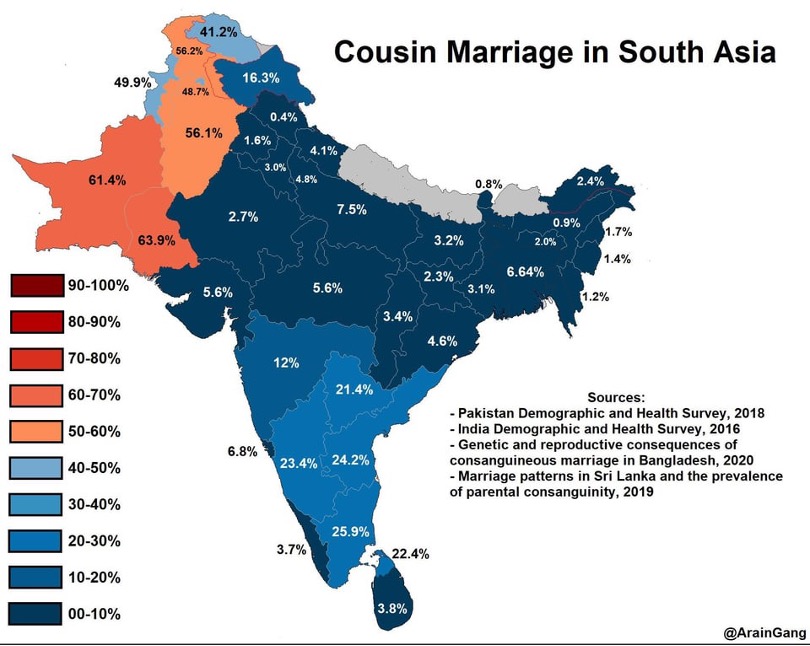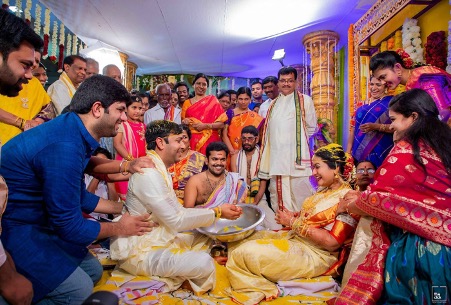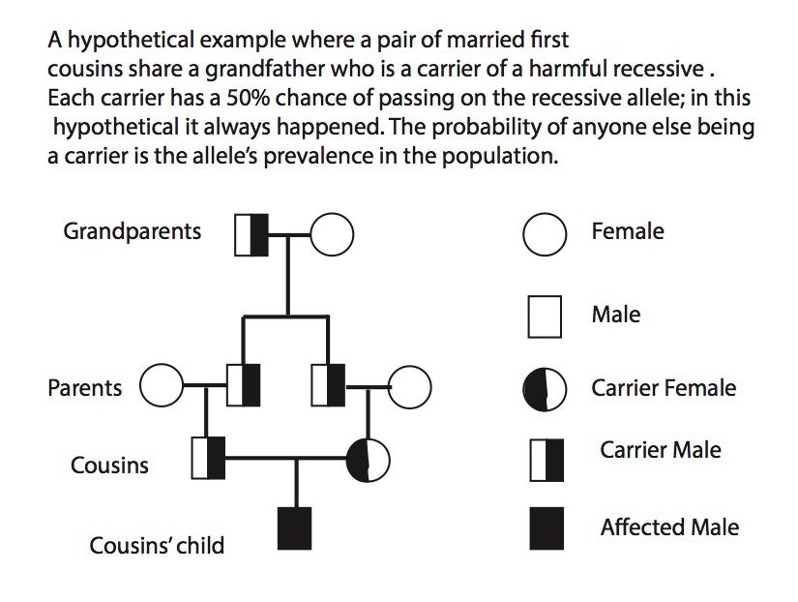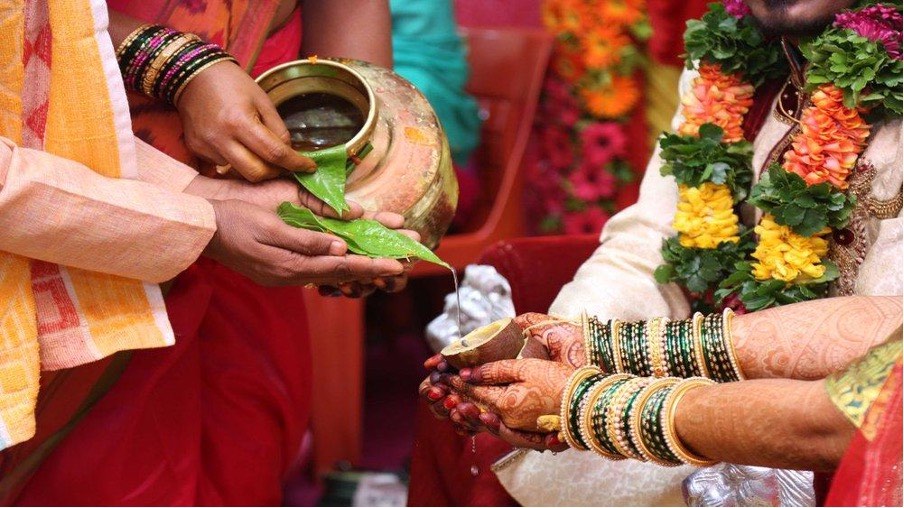The legal union of a man and a woman who are blood relatives with a shared ancestor is known as consanguineous marriage. First-cousin marriages are the most prevalent type of consanguineous union, with high incidences in Middle Eastern nations and southern Indian states. According to a comparison of the National Family Health Survey 1 and 4’s first and fourth waves, consanguineous marriages are becoming less common.
First cousins on both the father’s and mother’s sides make up the majority of consanguineous weddings. These unions are most frequently performed in the southern states of Andhra Pradesh, Telangana, Tamil Nadu, and Karnataka, with the exception of Kerala. Importantly, among the Other Backward Groups, Hindus in Southern India, Muslims in North India, and the less educated population of the middle and richer wealth index are more likely to practice consanguineous marriage.

In research published more than 50 years ago titled “Inbreeding and Endogamy in Kerala,” author SGM Ali discovered that Malayali Muslims were the most inbred group, closely followed by Nairs (a sect of Hindus). The investigation focused on 1,631 marriages among 20 endogamous groups. It also refers to past findings that Marathis and Malayans were the most inbred ethnic groups, followed by those from Andhra Pradesh. Additionally, the poll suggests that Muslim and Buddhist/Neo-Buddhist women are more likely to be in consanguineous marriages. However, Christians did not marry cousins up to the fourth degree of consanguinity, according to SGM Ali’s study.
In South India, cousin marriages have a long history dating back many centuries. There are several reasons why cousin marriages are so common in South India. They are frequently viewed as a method to maintain economic stability, family and community links, and the compatibility of the partners with regard to culture, religion, and social standing. Cousin marriages are seen in many South Indian cultures as strengthening family relationships and upholding a sense of tradition and continuity.
The origins of cousin marriages in Kerala, South India, are shrouded in historical complexity and multifaceted social dynamics. Historian MG Sasibhooshan, in his exploration of this intriguing tradition, presents several compelling theories that shed light on the possible genesis of cousin marriages.
One theory, proposed by the late historian Elamkulam Kunjan Pillai, suggests that such marriages could have evolved in primitive societies. In these ancient times, men often engaged in warfare, making it challenging to seek alliances beyond their immediate family circles. This practice transcended religious boundaries, with both Hindus and Muslims partaking in cousin marriages. This tradition was not confined to the Kerala region alone; it also found its place in Tamil Nadu and even extended as far as Sri Lanka. In this way, cousin marriages served as a practical solution in a time when forming alliances was no simple endeavor.

Another theory hinges on the idea that, in ancient times, people were inclined not to seek marriage alliances beyond specific geographical boundaries. These boundaries often took the form of natural landmarks, such as rivers.
Another commonly acknowledged hypothesis contends that cousin unions in Kerala were planned ways to preserve the family’s riches. This practice is frequently linked to the matrilineal inheritance system known as “marumakathayam.” In this system, a nephew rather than the son inherits the family’s riches. Marriages were set up between a daughter and a nephew to guarantee that the family’s wealth was passed down only via the female line. In addition to protecting financial holdings, this tradition also aimed to preserve continuity and family solidarity.
While empirical evidence is adequate to answer the question of how common cousin marriages prevail in South India, it also raises the possibility that, because of a shared genetic lineage, children of cousin marriages are more likely to have genetic diseases. These unions may increase the chance of autosomal recessive illnesses, according to studies.
Additionally, actual research from several nations has repeatedly shown that children of cousin marriages are more likely to suffer congenital abnormalities and intellectual problems. The alleged genetic risks are linked to a process known as unmasking. It works like this: Each of our parents gives us a single copy of each gene. As a result, we inherit two alleles (also known as copies) of each gene, one of which may be dominant and the other recessive. Both copies of a recessive gene must be the recessive allele for it to be present in a person.
A person is regarded as a carrier when they have one recessive allele of the gene and can pass on the risk of sickness to their progeny. However, a recessive allele is said to be unmasked, and the disease is said to be inherited when a person has two copies of the risky allele. The risk of passing on the harmful allele to a kid is 50% for each carrier. However, few people are carriers when a gene is uncommon in the population.

The issue is that cousins have the same grandparents. Although it is unlikely that each grandparent would carry a rare gene, if one grandparent does, there is a 50% probability that each of their offspring (the cousins’ parents) will also be carriers. Therefore, compared to non-related marriages, there is a higher likelihood that a child may acquire two copies of a risky gene since they have a better chance of receiving the same recessive allele from their common forebears.
Congenital abnormalities are more likely to occur in children born to closely connected parents, according to research. These anomalies may lead to long-term health issues, impacting various organs and systems. In regions where cousin marriages are popular, diseases like thalassemia and cystic fibrosis are more prevalent. Additionally, genetic diversity may be lowered due to inter-family or inter-community marriage, reducing the gene pool and increasing susceptibility to genetic illnesses while lowering the population’s capacity to adapt to changing environmental factors.
A thorough research study, including 11,000 offspring from consanguineous marriages, was mentioned in a 2013 article in The Hindu. According to the study, 386 of these children had congenital abnormalities, representing a doubling of the proportion of children with abnormalities born to unrelated parents. Kerala may have taken these findings seriously when contemplating cousin weddings, given the state’s rising literacy levels over the years.
Due to the poor sample techniques employed, studies on the impact of cousin marriage on polygenic characteristics and complicated illnesses of adulthood sometimes provide inconsistent results. Heart disease and breast cancer have been linked in both favorable and negative ways. Numerous polygenic variables, including height, BMI, intellect, and cardiovascular profile, appear to be impacted by consanguinity. Inbreeding has been linked positively to a wide range of common adult disorders, including hypertension, coronary heart disease, stroke, cancer, uni/bipolar depression, asthma, gout, peptic ulcer, and osteoporosis, according to long-term studies done on the Dalmatian islands in the Adriatic Sea. However, rather than consanguinity in general, these data may mostly represent village endogamy.
Apart from genetic implications, social isolation may result from cousin unions. This is due to the fact that cousins are sometimes regarded as belonging to the same extended family, which may drive them to interact with people outside of their own family less frequently. Children who may not have the chance to acquire a wide variety of social skills might be particularly harmed by this. Additionally, issues within the family might result from cousin marriages due to the possibility of a power disparity between the husband and wife. Frequently, the female is expected to be obedient to the husband, who is viewed as the leader of the home. When the wife is unable to leave the marriage, this might result in violence and abuse.
Cousin marriages in South India are a complex issue with deep-rooted historical, socio-cultural, and medical implications. While these unions are often seen as a means of preserving traditions and maintaining family bonds, they also carry an increased risk of genetic disorders and other health issues. It is essential to strike a balance between cultural heritage and the well-being of future generations. However, cousin marriages have decreased in number with women getting educated and becoming more aware of the medical consequences. Even among younger generations, the practice of voluntary cousin marriages exists as it has been passed down through the years; therefore, it is still not entirely gone.
Education campaigns, genetic counseling, and neighborhood projects may all help spread the word about the possible dangers of cousin unions and provide people with the knowledge they need to make wise choices. To address the medical ramifications and look for measures to reduce health risks while recognizing the traditional value of cousin weddings in South India, policymakers and healthcare practitioners should collaborate. By doing this, we can preserve our unique cultural history and protect the health and welfare of coming generations.
Written by – Hiya Gaywala
Edited by – Kushi Mayur




